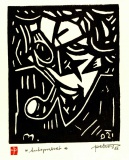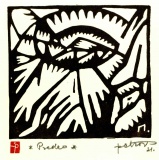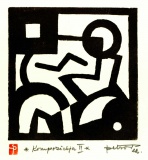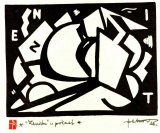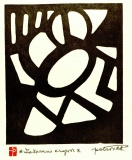Difference between revisions of "Mihailo Petrov"
| Line 1: | Line 1: | ||
| + | |||
'''Mihailo S. Petrov''' (1902–1983, Belgrade) was a graphic artist, painter, illustrator, poet and critic, professor, book and poster designer and typographer. He studied painting at art school in Belgrade with prof. Lj Ivanovic and M. Milovanovic (1919-21), and continued in Vienna (1922), Kraków (1923), and Paris (1924-25). | '''Mihailo S. Petrov''' (1902–1983, Belgrade) was a graphic artist, painter, illustrator, poet and critic, professor, book and poster designer and typographer. He studied painting at art school in Belgrade with prof. Lj Ivanovic and M. Milovanovic (1919-21), and continued in Vienna (1922), Kraków (1923), and Paris (1924-25). | ||
By way of Stanislav Vinaver, who was in Belgrade collecting contributions for ''[[Zenit]]'', Petrov became one of its most active collaborators in its early phase from 1921, creating linocuts which came to represent the culmination of his oeuvre. | By way of Stanislav Vinaver, who was in Belgrade collecting contributions for ''[[Zenit]]'', Petrov became one of its most active collaborators in its early phase from 1921, creating linocuts which came to represent the culmination of his oeuvre. | ||
| − | The linocuts ''Self- | + | The linocuts ''[http://digitalna.nb.rs/wb/NBS/casopisi_pretrazivi_po_datumu/Zenit/1921/b006#page/4/mode/1up Autoportret]'' [Self-Portrait] and ''[http://digitalna.nb.rs/wb/NBS/casopisi_pretrazivi_po_datumu/Zenit/1921/b006#page/9/mode/1up Današnji zvuk]'' [Present-Day Sound] are printed with his poem ''[http://digitalna.nb.rs/wb/NBS/casopisi_pretrazivi_po_datumu/Zenit/1921/b006#page/9/mode/1up Fragmenat naših Grehova]'' [Fragment of Our Sins] with the notation: "Very young and very affirming. Our new value. One should only feel it" (''Zenit'' 6, 1921), followed by ''[http://digitalna.nb.rs/wb/NBS/casopisi_pretrazivi_po_datumu/Zenit/1921/b008#page/3/mode/1up Predeo]'' [Landscape] (No. 8), ''[http://digitalna.nb.rs/wb/NBS/casopisi_pretrazivi_po_datumu/Zenit/1921/b009#page/6/mode/1up Linoleum]'' (No. 9), ''[http://digitalna.nb.rs/wb/NBS/casopisi_pretrazivi_po_datumu/Zenit/1921/b010#page/0/mode/1up Ritam]'' [Rhythm] (No. 10), ''[http://digitalna.nb.rs/wb/NBS/casopisi_pretrazivi_po_datumu/Zenit/1922/b012#page/5/mode/1up Linoleum]'' (No. 12), and ''[http://digitalna.nb.rs/wb/NBS/casopisi_pretrazivi_po_datumu/Zenit/1922/b013#page/7/mode/1up Zenit]'' [Zenith] (No. 13). He also published the poem ''[http://digitalna.nb.rs/wb/NBS/casopisi_pretrazivi_po_datumu/Zenit/1922/b011#page/5/mode/1up Ritmi iz pustinje (pesma nalik na pismo)]'' [Rhythm From the Desert: Song Similar to a Letter] (''Zenit'' 11). The print ''Današnji zvuk'' was republished in [[Ivan Goll]]'s book ''Paris brennt'' (the second book of the Zenit Editions, 1921). For these works Petrov is likely to have been inspired by [[Kandinsky]], whose texts he translated into Serbian. He executed a reduced, geometrical drawn portrait of [[Ljubomir Micic]] which was printed on the cover of the catalogue for the [[The_First_Zenit_International_Exhibition_of_New_Art|International Exhibition of New Art]] (''Zenit'' 25, 1924). |
Petrov participated with a single work in the ''Zenit Exhibition'' (according to the catalog), although critics mention more paintings (in oil with "vivid colors", which were not precisely marked). Micic's collection included three of Petrov's works: ''Composition'' (1922), made under the influence of Kandinsky and [[Rodchenko]], the ''Portrait of Branko Ve Poljanski'' (1924), mildly geometric figure, dandy suit styling with urban vista in the background, and a third work, a poster for the International Exhibition "Zenit" (1924), with exaggerated stylization of the urban environment, clear colors and collage parts taken from the catalogue of the exhibition. The last work is one of the earliest collages from the region. During his zenitist period, Petrov produced an extraordinary work, ''Composition 77'' (Collection of the Museum of Contemporary Art, Belgrade) - dedicated to Branko Poljanski in anagram, and thematically related to his book ''77 Suicides'' (1924). | Petrov participated with a single work in the ''Zenit Exhibition'' (according to the catalog), although critics mention more paintings (in oil with "vivid colors", which were not precisely marked). Micic's collection included three of Petrov's works: ''Composition'' (1922), made under the influence of Kandinsky and [[Rodchenko]], the ''Portrait of Branko Ve Poljanski'' (1924), mildly geometric figure, dandy suit styling with urban vista in the background, and a third work, a poster for the International Exhibition "Zenit" (1924), with exaggerated stylization of the urban environment, clear colors and collage parts taken from the catalogue of the exhibition. The last work is one of the earliest collages from the region. During his zenitist period, Petrov produced an extraordinary work, ''Composition 77'' (Collection of the Museum of Contemporary Art, Belgrade) - dedicated to Branko Poljanski in anagram, and thematically related to his book ''77 Suicides'' (1924). | ||
| Line 9: | Line 10: | ||
Petrov was also collaborating with the avant-garde magazines ''[[Dada Tank]]'' and ''[[Ut]]''. He was a member of Group Oblik / Form from 1926-29. After his collaboration with ''Zenit'' (which ended due to financial matters), he produced prints, paintings with conventional and intimate themes and expressive color during the entire decade. He founded the Graphic Department at the Academy of Fine Arts and the Academy of Applied Arts in Belgrade. He was also one of the organizers of the 6th Yugoslav Exhibition in Novi Sad in 1927, and the first graphic exhibitions in Belgrade in 1934. In the postwar period, he returned to making abstract prints, adding enformel and lyrical structures. [http://www.avantgarde-museum.com/en/museum/collection/MIHAILO-S.-PETROV~pe4514/ (Based on the source)] | Petrov was also collaborating with the avant-garde magazines ''[[Dada Tank]]'' and ''[[Ut]]''. He was a member of Group Oblik / Form from 1926-29. After his collaboration with ''Zenit'' (which ended due to financial matters), he produced prints, paintings with conventional and intimate themes and expressive color during the entire decade. He founded the Graphic Department at the Academy of Fine Arts and the Academy of Applied Arts in Belgrade. He was also one of the organizers of the 6th Yugoslav Exhibition in Novi Sad in 1927, and the first graphic exhibitions in Belgrade in 1934. In the postwar period, he returned to making abstract prints, adding enformel and lyrical structures. [http://www.avantgarde-museum.com/en/museum/collection/MIHAILO-S.-PETROV~pe4514/ (Based on the source)] | ||
| − | + | ==Works== | |
| + | <gallery> | ||
| + | Petrov Mihailo 1921 Self-Portrait.jpg|''Autoportret'' [Self-Portrait], 1921, printed 1971. Linocut. | ||
| + | Petrov Mihailo 1921 Landscape.jpg|''Predeo'' [Landscape], 1921, printed 1971. Linocut. | ||
| + | Petrov Mihailo 1921 Rhythm.jpg|''Ritam'' [Rhythm], 1921, printed 1971. Linocut. | ||
| + | Petrov Mihailo 1922 Composition II.jpg|''Kompozicja II'' [Composition II], 1922, printed 1971. Linocut. | ||
| + | Petrov Mihailo 1922 Zenith.jpg|''Zenit'' [Zenith], 1922, printed 1971. Linocut. | ||
| + | Petrov Mihailo 1922 Vicious Circle.jpg|''Zacarani krugovi'' [Vicious Circle], 1922, printed 1971. Linocut. | ||
| + | Petrov Mihailo 1922 Bridges.jpg|''Mostovi'' [Bridges], 1922, printed 1971. Linocut. | ||
| + | </gallery> | ||
| + | |||
| + | ==Links== | ||
* http://www.riznicasrpska.net/likovnaumetnost/index.php?topic=255.0 | * http://www.riznicasrpska.net/likovnaumetnost/index.php?topic=255.0 | ||
* http://www.mpu.rs/english/temporary/izlozbe_2013/09_mihajlo_petrov/mihajlo_petrov_eng.html | * http://www.mpu.rs/english/temporary/izlozbe_2013/09_mihajlo_petrov/mihajlo_petrov_eng.html | ||
Revision as of 12:42, 4 April 2016
Mihailo S. Petrov (1902–1983, Belgrade) was a graphic artist, painter, illustrator, poet and critic, professor, book and poster designer and typographer. He studied painting at art school in Belgrade with prof. Lj Ivanovic and M. Milovanovic (1919-21), and continued in Vienna (1922), Kraków (1923), and Paris (1924-25).
By way of Stanislav Vinaver, who was in Belgrade collecting contributions for Zenit, Petrov became one of its most active collaborators in its early phase from 1921, creating linocuts which came to represent the culmination of his oeuvre.
The linocuts Autoportret [Self-Portrait] and Današnji zvuk [Present-Day Sound] are printed with his poem Fragmenat naših Grehova [Fragment of Our Sins] with the notation: "Very young and very affirming. Our new value. One should only feel it" (Zenit 6, 1921), followed by Predeo [Landscape] (No. 8), Linoleum (No. 9), Ritam [Rhythm] (No. 10), Linoleum (No. 12), and Zenit [Zenith] (No. 13). He also published the poem Ritmi iz pustinje (pesma nalik na pismo) [Rhythm From the Desert: Song Similar to a Letter] (Zenit 11). The print Današnji zvuk was republished in Ivan Goll's book Paris brennt (the second book of the Zenit Editions, 1921). For these works Petrov is likely to have been inspired by Kandinsky, whose texts he translated into Serbian. He executed a reduced, geometrical drawn portrait of Ljubomir Micic which was printed on the cover of the catalogue for the International Exhibition of New Art (Zenit 25, 1924).
Petrov participated with a single work in the Zenit Exhibition (according to the catalog), although critics mention more paintings (in oil with "vivid colors", which were not precisely marked). Micic's collection included three of Petrov's works: Composition (1922), made under the influence of Kandinsky and Rodchenko, the Portrait of Branko Ve Poljanski (1924), mildly geometric figure, dandy suit styling with urban vista in the background, and a third work, a poster for the International Exhibition "Zenit" (1924), with exaggerated stylization of the urban environment, clear colors and collage parts taken from the catalogue of the exhibition. The last work is one of the earliest collages from the region. During his zenitist period, Petrov produced an extraordinary work, Composition 77 (Collection of the Museum of Contemporary Art, Belgrade) - dedicated to Branko Poljanski in anagram, and thematically related to his book 77 Suicides (1924).
Petrov was also collaborating with the avant-garde magazines Dada Tank and Ut. He was a member of Group Oblik / Form from 1926-29. After his collaboration with Zenit (which ended due to financial matters), he produced prints, paintings with conventional and intimate themes and expressive color during the entire decade. He founded the Graphic Department at the Academy of Fine Arts and the Academy of Applied Arts in Belgrade. He was also one of the organizers of the 6th Yugoslav Exhibition in Novi Sad in 1927, and the first graphic exhibitions in Belgrade in 1934. In the postwar period, he returned to making abstract prints, adding enformel and lyrical structures. (Based on the source)
